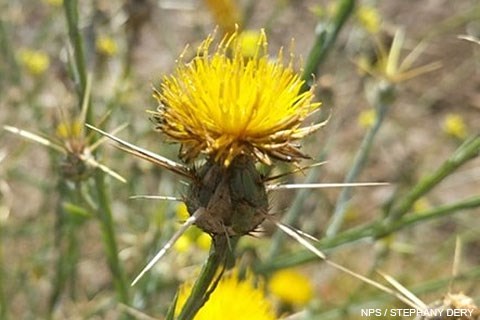
There is a silent yet sinister struggle occurring at Point Reyes National Seashore. Native habitats are being significantly altered as invasive, non-native plant species out-compete native plants. As natives are replaced by non-natives, "habitat value" (the ability for an area to support the natural variety of plant and animal species) decreases. Non-native species are one of the most serious threats to the earth's biodiversity. Second only to habitat destruction, they threaten about half of all endangered species (Wilcove 1998)! All it takes is one seemingly harmless seed to disturb natural systems that have been in place for hundreds of thousands of years. Click on a link below to read more. A Blight on the Land 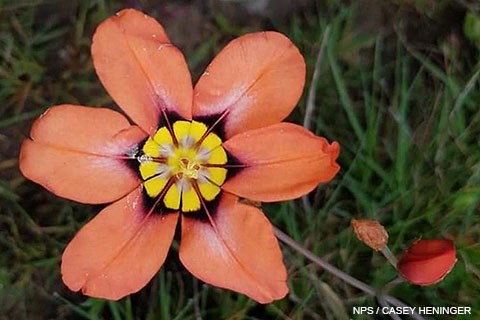
A Blight on the LandInvasive species are those plants that are able to rapidly move into and dominate or disrupt native communities. Most are nonnative, meaning that they are not naturally present in an area, but were introduced by humans. Other names include "non-indigenous," "alien," "exotic pest plant," or "weed." Free from the vast and complex array of natural controls present in their native lands—including competition, herbivores, parasites, and diseases—exotic plants may experience rapid and unrestricted growth in new environments. Invasiveness is characterized by any or all of the following: strong vegetative growth, abundant seed production, high seed germination rate, long-lived seeds, and rapid maturation to a sexually reproductive (seed-producing) stage or the ability to quickly reproduce vegetatively (clonally). Their phenomenal growth allows them to overwhelm and displace existing vegetation and form dense stands. In the mid-1800s, exotic weeds began arriving with immigrants from overseas. Many were intentionally brought to California by settlers for use as garden and ornamental plants, or in hopes of making profit through agriculture or timber harvesting. Others have been unintentionally introduced in our highly mobile global society. Seeds or other reproductive plant parts can "hitchhike" in bedding, livestock feed, firewood, tires, gravel, ship cargo, on animals, and even on people's clothing. Not all exotics are disruptive, but those weeds that have no natural competitors or predators to control their numbers in new habitats can expand quickly. The introduction of harmful exotic species is a global problem. A 1998 study published in BioScience concluded that invasive species contribute to the endangerment of 49 percent of all species (and 57% of plant species) designated as threatened and endangered under the Endangered Species Act (Wilcove, 1998). A 2005 Cornell University study estimated that invasive plants and animals cost the US economy $120 billion annually (Pimentel, 2005). Non-native plants are generally present in areas that have been disturbed (usually by human use), such as roadsides, grazed pastures, old homesteads, campgrounds and trails, but the most invasive species eventually move into pristine natural communities as well. As of 2017, there were over 1.4 million acres of national park units infested with invasive plants, of which only approximately 43,000 acres are controlled, in which invasive plant infestations have been reduced to a level that can be maintained by park staff (NPS 2017). Visit the National Park Service's Invasive Species Management site to learn more. Visit the Integrated Pest Management section below to learn how Point Reyes National Seashore staff are attempting to protect native flora and fauna by reducing invasive plant species. 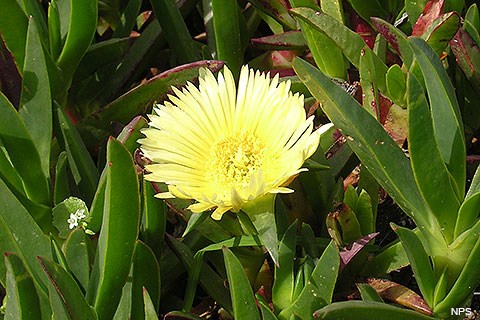
Changing Our Natural EcosystemsExotic pest plants can have many negative impacts on native ecosystems, by disturbing a community's natural equilibrium that has evolved over hundreds of thousands of years. They displace native flora and fauna by competition for and often monopolization of resources (water, light, nutrients, and space). Some plants, such as eucalyptus and iceplant, even use allelopathy, or chemical defenses, to inhibit growth of other plant species. Invasive plants can severely alter sensitive habitats like marshes or riparian areas, affecting critical watershed health. Some invasive plant species may cause harm to native fauna. For example, European beachgrass reduces and degrades western snowy plover habitat; iceplant outcompetes native dune plants that feed the Myrtle's silverspot butterfly; and cape-ivy can be toxic to native fish. Population Action International and Conservation International have determined that the California Floristic Province (CFP) is a "global biodiversity hotspot"--one of only 25 terrestrial regions worldwide where biological diversity is most concentrated and the threat of loss most severe (Cincotta and Engleman 2000; Conservation International 2007). Forty percent of California's grass species are exotic; today it is rare to find a pristine native California coastal prairie community, and the dominance of exotic grasses over native bunch grass species could increase with global warming (Sandel and Dangremond 2012). This is only one example of how exotic pest plants can alter the structure, function, and composition of native communities, and degrade the overall health of natural ecosystems. Within the CFP, Population Action International found that original flora covers only 25% of the landscape, with only 9.7% of this land protected in parks, reserves, refuges, and other areas off-limits to development and resource exploitation. Point Reyes National Seashore supports 49 special status rare plant species (and manages others found on the northern lands of Golden Gate National Recreation Area), many of which are directly affected by invasive non-native species. While National Park status has protected the native flora at Point Reyes from development, only active restoration will protect the native flora from invasive species. Diversity is the spice of lifeThe natural world we know and love depends on the incredibly complex underlying web of life's diversity. Over billions of years of evolution, each of the millions of species on earth has found its unique part to play in the mysterious dance of life. Some invasive plants create monocultures (areas containing only a single species), which lower the area's biodiversity by decreasing the number of plant species and the variety of growth forms, as well as diminishing suitable forage for many native animals. Some plant species directly threaten the existence of rare and endangered plants and animals. On the Pacific Coast at Point Reyes, European beach grass creates large, stable foredunes and inhibits natural sand movement, severely limiting available habitat for federally listed endangered or threatened species, such as the western snowy plover, Tidestrom's lupine, and beach layia. 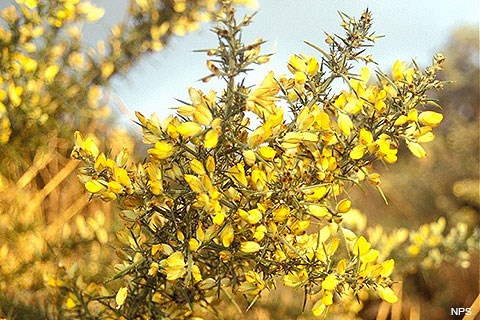
Choosing Our BattlesThe goal of the National Park Service is to preserve and protect land, resources, and native ecosystems in their natural state. Unfortunately, it is often very difficult to fully restore native communities due to the severity of changes in soil and community composition, structure, and function caused by plant invaders. Of the almost 900 plant species in the park, about 300 are non-native, with about 10% of the non-native species being both problematic to our ecosystems and feasible for management with current methods. By necessity, management of invasive vegetation at Point Reyes National Seashore focuses on species that most seriously threaten native habitats, wildlife, and endangered plant and animal species, and are the most feasible targets for eradication efforts. Ideally, removal and containment efforts are focused on species when their populations are still small, but if a species is established in a remote area, its presence may not be noticed until the population, and the problem, is large. Vegetation management personnel work to map and prioritize target species in the park. Several invasive species are too widespread for total control to be possible. In these cases, priority for control is given to high-value areas, such as the Lighthouse or Abbotts Lagoon areas, where rare dune plants and plant communities still maintain a fragile foothold. Top priority species and/or populations are removed when there are enough resources to do so, and sites are revisited to prevent the weeds from reestablishing themselves. Visit our Abbotts Lagoon Coastal Dune Restoration Project page to learn about a recent large-scale removal of European beachgrass (Ammophila arenaria) and iceplant (Carpobrotus spp.) near Abbotts Lagoon. Treatment of invasive plants can be very costly. For instance, in FY2009 the National Park Service received a $20 million increase for treating invasive populations and reintroducing native plant species (NPS 2008). Thus, preventing invasions from occurring and spreading, and responding rapidly while infested acres are small, is essential. It is also crucial to quantify removal costs and subsequent results, and to use resources for cost-efficient control methods in the highest-value areas. As invaders do not respect the complicated jurisdictions of Marin's many land management agencies, partnership among the agencies is required to understand distributions, recognize new invaders, prioritize effective treatments, and work with our communities to prevent infestations. One such partnership is the Marin/Sonoma Weed Management Area. Integrated Pest Management at Point Reyes National SeashoreAt Point Reyes National Seashore (PRNS), chemical treatment of pests is always the method of last resort. PRNS uses an Integrated Pest Management (IPM) approach, in which pesticides are selected only if other methods are unavailable or unfeasible. An IPM approach is used throughout the National Park Service. For invasive plants, methods are designed to minimize the number of return visits and to improve the likelihood of native plant establishment, so that eventually, natural areas will not need manipulation to stay weed-free. Unfortunately, some invasive plants actually spread faster if only manual methods of removal are attempted. Based on the literature, expert consultation, and professional judgment of NPS biologists, without some targeted and judicious use of herbicides, we risk losing populations of rare, endangered, and threatened plants and animals. The Scotch broom control project is a recent example of PRNS's use of Integrated Pest Management. Scotch broom is a high-priority invasive plant that can form monocultures and crowd out all other native vegetation. It contains chemical compounds that can be toxic to native wildlife and plants and causes changes in soils and hydrology that can be ecosystem-altering. Scotch broom has been treated at PRNS using fire, heavy equipment, and manual tools since the 1990s. Our goal is to treat all known Scotch broom infestations within the park by 2014. With current funding, more than two-thirds of the 171 acres treated have been removed manually or mechanically. To stop this invasion quickly and effectively enough to protect rare species and native plant communities, PRNS staff decided to treat the remaining Scotch broom with herbicides, adhering to the following herbicide use protocols and mitigations:
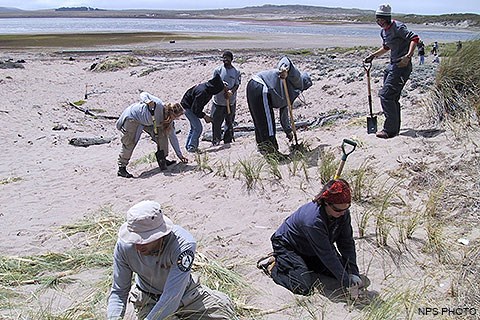
Be Part of the SolutionWhile Visiting Point Reyes National SeashoreVolunteer! Volunteers may assist with activities beneficial to habitat restoration, such as rare plant or stream and tidepool monitoring, native seed collection plant propagation, and stream stabilization. For more information, contact the park's volunteer coordinator at 415-464-5225. Visit the San Francisco Bay Area Inventory & Monitoring Network's Invasive Plants Early Detection page to learn more and to download Plant ID Cards featuring some of the high-priority invasive species. These plant-out-of-place cards are designed to help visitors with the identification of new invaders of Point Reyes National Seashore while exploring the park. If you see any of these plants in the park, take a photo of it or provide a detailed description and note precisely where you found the plant, and then LET US KNOW by email. If you see these plants-or any other unusual plants-growing in the open space lands of the Bay Area, contact the landowner, your county agriculture department, or a cooperative extension agent. Or report confirmed infestations directly through Calflora's Plant Observation Entry application. Visit our Help Stop the Spread of Non-Native Species page for additional information. At HomeYou can also help after you leave the Seashore. Know and appreciate the distinction between garden plants and plants in natural ecosystems in your area. Understand where they belong, and keep them separate, if you have the power to do so. Don't spread any seeds while hiking; don't pick fruits or parts of plants and carry them with you to other places. Checking your clothes and cleaning your boots between outings is good prevention. At home, consider removing invasive plants from your property and planting native ones (or non-invasive exotics) instead. Gardening and landscaping with native flora usually requires less work, since indigenous plants have evolved to survive in the local environment. They also can make your home a colorful, lively place, by attracting native songbirds and butterflies. Here are some links to get you started:
Our forests across the country are threatened by nonnative insects and diseases that can kill large numbers of trees. Sudden Oak Death, Gold spotted oak borer, pitch canker, Emerald ash borer, and Asian long horned beetle can be transported long distances in firewood. Once transported into new areas, these insects and diseases can become established and kill local trees. Learn how you can help reduce the risk of spreading nonnative insects and diseases. Preventing the spread of exotic pest plants depends on the awareness, support, and especially participation of everyone, so remember to do your part! Each person's actions matter; don't doubt your personal power to help preserve our world as evolution and Mother Nature have created it. Working together we can protect the unique natural resources of our area. View Nonnative Plants of Point Reyes National Seashore species list (22 KB PDF). ReferencesConservation International. 2007. Biodiversity Hotspots: California Floristic Province National Park Service: Biological Resources Division: Invasives Species Management. National Park Service: Invasive & Non-Native Species: Invasive Plants.
Science & Research Project SummariesFrom 2006 to 2018, Point Reyes National Seashore and Pacific Coast Science and Learning Center (PCSLC) staff and communication interns assisted scientists conducting research through the PCSLC and the San Francisco Bay Area Inventory & Monitoring Network to produce a series of Resource Project Summaries, six of which were, in part, about non-native species at Point Reyes. These one- to two-page summaries provide information about the questions that the researchers hoped to answer, details about the project and methods, and the results of the research projects in a way that is easy to understand.
MultimediaOn August 15, 2024, KQED's Bay Curious podcast published an article and a podcast entitled "Pretty, but Not 'Nice': California's Invasive Ice Plant" about ice plant at Point Reyes National Seashore and efforts to remove it. Photo Gallery |
Last updated: August 29, 2024
